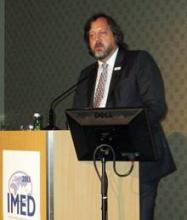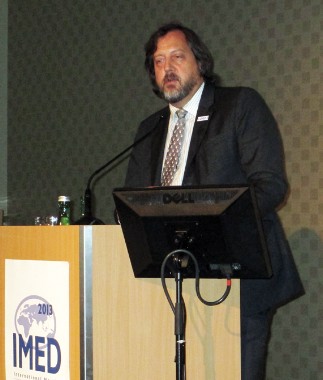User login
VIENNA – Look for promotion of FluNearYou, a new form of crowd-source epidemiology first rolled out to the general U.S. public last September and now up to 50,000 active participants, to intensify next summer, said one of the program’s designers.
"Now that we are confident that people are interested and stay in the system, we will have a massive campaign next flu season to really build it out and see how far we can take it in the United States," Dr. Mark Smolinski said at the International Meeting on Emerging Diseases and Surveillance. FluNearYou represents the first phase of what will likely be a series of participatory surveillance tools that allow the general public to submit real-time infection epidemiology data.
"We’re thinking about engaging the public directly for all emerging infectious diseases, expanding to include more symptoms and extend the geography," said Dr. Smolinski, director of global health threats for the Skoll Global Threats Fund in San Francisco.
People who sign up for FluNearYou, via the Internet or an app, receive a weekly query that asks them to submit whether they have, in the last week, had any of 10 influenzalike symptoms (the query also asks participants if they received their seasonal flu vaccine as a reminder to do so). The FluNearYou software then analyzes the symptom information to determine whether the participant likely has flu and then maps information on probable cases, providing participants as well as public health officials a real-time map of flu prevalence at any time.
The goal is to "reduce the lag in identifying outbreaks so that everyone has access to the information at the same time," said John Brownstein, Ph.D., an epidemiologist at Children’s Hospital in Boston who has led development of Health Map, a web-based tool for tracking the status of infectious diseases worldwide. In a separate talk at the meeting, Dr. Brownstein stressed that new methods of crowd-sourced epidemiology are seen as complements rather than replacements for traditional mechanisms of infectious disease surveillance.
"We hope to continue to move the time to identify infection outbreaks down further – fast enough so that we can eliminate the threat of pandemics spreading around the world," Dr. Smolinski said. FluNearYou came about when Dr. Smolinski and his associates decided to "just ask people directly whether they have flulike symptoms."
FluNearYou debuted in 2011 with pilot testing among members of the American Public Health Association, which resulted in about 8,000 participants by early last fall. Last September, Dr. Smolinski and his associates at Skoll began publicizing the program in the San Francisco area, primarily through advertisements on public transit vehicles, which produced about 50,000 active participants by early 2013. Nationwide publicity and enrollment is the next step, he said.
Crowd-sourced epidemiology programs for flu are now in place in Europe as Influenzanet and in Australia, and the goal is to eventually merge these systems and have them cover the entire globe, Dr. Smolinski said. He also noted that the Centers for Disease Control and Prevention has launched a pilot study with a modified version of FluNearYou, with queries for a few additional symptoms, in Puerto Rico as a way to distinguish and track cases of influenza, dengue, and leptospirosis.
FluNearYou is sponsored by the Skoll Global Threats Fund and the Skoll Foundation. Dr. Smolinski is an employee of the fund. Dr. Brownstein had no disclosures.
VIENNA – Look for promotion of FluNearYou, a new form of crowd-source epidemiology first rolled out to the general U.S. public last September and now up to 50,000 active participants, to intensify next summer, said one of the program’s designers.
"Now that we are confident that people are interested and stay in the system, we will have a massive campaign next flu season to really build it out and see how far we can take it in the United States," Dr. Mark Smolinski said at the International Meeting on Emerging Diseases and Surveillance. FluNearYou represents the first phase of what will likely be a series of participatory surveillance tools that allow the general public to submit real-time infection epidemiology data.
"We’re thinking about engaging the public directly for all emerging infectious diseases, expanding to include more symptoms and extend the geography," said Dr. Smolinski, director of global health threats for the Skoll Global Threats Fund in San Francisco.
People who sign up for FluNearYou, via the Internet or an app, receive a weekly query that asks them to submit whether they have, in the last week, had any of 10 influenzalike symptoms (the query also asks participants if they received their seasonal flu vaccine as a reminder to do so). The FluNearYou software then analyzes the symptom information to determine whether the participant likely has flu and then maps information on probable cases, providing participants as well as public health officials a real-time map of flu prevalence at any time.
The goal is to "reduce the lag in identifying outbreaks so that everyone has access to the information at the same time," said John Brownstein, Ph.D., an epidemiologist at Children’s Hospital in Boston who has led development of Health Map, a web-based tool for tracking the status of infectious diseases worldwide. In a separate talk at the meeting, Dr. Brownstein stressed that new methods of crowd-sourced epidemiology are seen as complements rather than replacements for traditional mechanisms of infectious disease surveillance.
"We hope to continue to move the time to identify infection outbreaks down further – fast enough so that we can eliminate the threat of pandemics spreading around the world," Dr. Smolinski said. FluNearYou came about when Dr. Smolinski and his associates decided to "just ask people directly whether they have flulike symptoms."
FluNearYou debuted in 2011 with pilot testing among members of the American Public Health Association, which resulted in about 8,000 participants by early last fall. Last September, Dr. Smolinski and his associates at Skoll began publicizing the program in the San Francisco area, primarily through advertisements on public transit vehicles, which produced about 50,000 active participants by early 2013. Nationwide publicity and enrollment is the next step, he said.
Crowd-sourced epidemiology programs for flu are now in place in Europe as Influenzanet and in Australia, and the goal is to eventually merge these systems and have them cover the entire globe, Dr. Smolinski said. He also noted that the Centers for Disease Control and Prevention has launched a pilot study with a modified version of FluNearYou, with queries for a few additional symptoms, in Puerto Rico as a way to distinguish and track cases of influenza, dengue, and leptospirosis.
FluNearYou is sponsored by the Skoll Global Threats Fund and the Skoll Foundation. Dr. Smolinski is an employee of the fund. Dr. Brownstein had no disclosures.
VIENNA – Look for promotion of FluNearYou, a new form of crowd-source epidemiology first rolled out to the general U.S. public last September and now up to 50,000 active participants, to intensify next summer, said one of the program’s designers.
"Now that we are confident that people are interested and stay in the system, we will have a massive campaign next flu season to really build it out and see how far we can take it in the United States," Dr. Mark Smolinski said at the International Meeting on Emerging Diseases and Surveillance. FluNearYou represents the first phase of what will likely be a series of participatory surveillance tools that allow the general public to submit real-time infection epidemiology data.
"We’re thinking about engaging the public directly for all emerging infectious diseases, expanding to include more symptoms and extend the geography," said Dr. Smolinski, director of global health threats for the Skoll Global Threats Fund in San Francisco.
People who sign up for FluNearYou, via the Internet or an app, receive a weekly query that asks them to submit whether they have, in the last week, had any of 10 influenzalike symptoms (the query also asks participants if they received their seasonal flu vaccine as a reminder to do so). The FluNearYou software then analyzes the symptom information to determine whether the participant likely has flu and then maps information on probable cases, providing participants as well as public health officials a real-time map of flu prevalence at any time.
The goal is to "reduce the lag in identifying outbreaks so that everyone has access to the information at the same time," said John Brownstein, Ph.D., an epidemiologist at Children’s Hospital in Boston who has led development of Health Map, a web-based tool for tracking the status of infectious diseases worldwide. In a separate talk at the meeting, Dr. Brownstein stressed that new methods of crowd-sourced epidemiology are seen as complements rather than replacements for traditional mechanisms of infectious disease surveillance.
"We hope to continue to move the time to identify infection outbreaks down further – fast enough so that we can eliminate the threat of pandemics spreading around the world," Dr. Smolinski said. FluNearYou came about when Dr. Smolinski and his associates decided to "just ask people directly whether they have flulike symptoms."
FluNearYou debuted in 2011 with pilot testing among members of the American Public Health Association, which resulted in about 8,000 participants by early last fall. Last September, Dr. Smolinski and his associates at Skoll began publicizing the program in the San Francisco area, primarily through advertisements on public transit vehicles, which produced about 50,000 active participants by early 2013. Nationwide publicity and enrollment is the next step, he said.
Crowd-sourced epidemiology programs for flu are now in place in Europe as Influenzanet and in Australia, and the goal is to eventually merge these systems and have them cover the entire globe, Dr. Smolinski said. He also noted that the Centers for Disease Control and Prevention has launched a pilot study with a modified version of FluNearYou, with queries for a few additional symptoms, in Puerto Rico as a way to distinguish and track cases of influenza, dengue, and leptospirosis.
FluNearYou is sponsored by the Skoll Global Threats Fund and the Skoll Foundation. Dr. Smolinski is an employee of the fund. Dr. Brownstein had no disclosures.
AT IMED 2013
Major Finding: By February 2013, FluNearYou had about 50,000 active participants, up from about 8,000 in September 2012.
Data Source: Data came from FluNearYou.
Disclosures: FluNearYou is sponsored by the Skoll Global Threats Fund and the Skoll Foundation. Dr. Smolinski is an employee of the Ffund. Dr. Brownstein had no disclosures.

